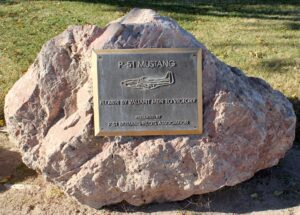P-51 Mustang
nellis air force base
Discription:
Small metal plaque mounted on a boulder. It contains the outlined image of a P-51 Mustang aircraft, and the words, “P-51 Mustang flown by valiant men to victory. Presented by P-51 Mustang Pilots Association.”
Responcible Organization/Individual:
P-51 Mustang Pilots Association
Designed By:
P-51 Mustang Pilots Association

Address:
Freedom Park, located inside Nellis Air Force Base, 4700 Las Vegas Blvd. North, North Las Vegas, NV, 89191-6600.
GPS Coordinates:
Hours Available
Ceremonies: no
History:
The North American Aviation P-51 Mustang is an American long-range, single-seat fighter and fighter-bomber used during World War II and the Korean War, among other conflicts. The Mustang was designed in April 1940 by a design team headed by James Kindelberger of North American Aviation (NAA) in response to a requirement of the British Purchasing Commission. The Purchasing Commission approached North American Aviation to build Curtiss P-40 fighters under license for the Royal Air Force (RAF). Rather than build an old design from another company, North American Aviation proposed the design and production of a more modern fighter. The prototype NA-73X airframe was rolled out on 9 September 1940, 102 days after the contract was signed, and first flew on 26 October. By 8 May 1945,[64] the 8th, 9th, and 15th Air Force’s P-51 groups claimed some 4,950 aircraft shot down (about half of all USAAF claims in the European theater, the most claimed by any Allied fighter in air-to-air combat) and 4,131 destroyed on the ground. Losses were about 2,520 aircraft. The 8th Air Force’s 4th Fighter Group was the top-scoring fighter group in Europe, with 1,016 enemy aircraft claimed destroyed. This included 550 claimed in aerial combat and 466 on the ground.
Freedom Park is located inside the gates of Nellis AFB and is home to many military memorials. The U.S. Air Force Warfare Center at Nellis reports directly to the Air Combat Command. The center was founded on Sept. 1, 1966, as the U.S. Air Force Tactical Fighter Weapons Center. It was later renamed the U.S. Air Force Warfare Center in October 2005. The Mission: The USAFWC conducts warfighter-centric live and virtual operational test and evaluation, tactics development, and advanced training to optimize Air Force capabilities and prepare airmen for joint, all domain combat operations. (Current as of August 2020)